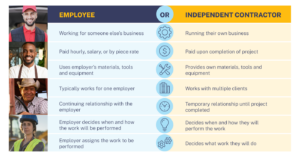Independent contractor agreements are pretty important right now because in 2022, the Department of Labor proposed a rule that would change how we classify independent contractors.
This will alter the way we create contracts and will change the circumstances that are facing lots of small businesses using independent contractors currently to meet their deadlines and to do business.
Many companies in the entertainment sphere are dependent on independent contractors, so let’s talk about what that means.
In 1989, the Supreme Court determined a case called Community for Creative Non-Violence v Reid. This was a copyright ownership case, but to determine the ownership of the copyright, the court looked at whether the individual was an employee or an independent contractor. And that was important because under the copyright definitions under Title 17, section 101, at the very, very bottom of the list under “W” for “Work Made For Hire,” you will see there are only two circumstances which require that to apply. And the first is being an employee.
The court was interested in what determines employment versus independent contractor status, and therefore what determines whether the individual owned their copyright or if the employer owned the copyright by virtue of the employer-employee relationship.
The 10 factors the court considered
The legal precedent that was issued under this case named 10 factors, and they’re what we call a “totality of the circumstances test,” meaning no one factor carries more weight over the others (although some courts might disagree with that position):
- The sources and the instrumentalities of the tools.
- The location of the work.
- The duration of the relationship between the parties.
- Whether the hiring party has the right to assign additional projects to the hired party.
- The extent of the hired party’s discretion over when and how long to work.
- Their method of payment.
- The hired party’s role in hiring and paying assistance.
- Whether this work is part of the regular business provided by the hiring party.
- The provision of benefits, employee benefits.
- The tax treatment of the hired party.
What does this mean for us now?
Last fall, the U.S. Department of Labor published a Notice of Proposed Rulemaking (NPRM), inviting the public to comment on their decision to bring the classification of independent contractors more in line with the definitions under the Fair Labor Standards Act (FLSA), which is the labor statute that applies to wage earners.
Their proposal is to rescind the rule and replace it with a new way of defining independent contractors.
Why are they doing this?
The misclassification of independent contractors versus employees is a very serious issue. 
If one is misclassified as an independent contractor when they are an employee, they’re denied certain benefits and protections under the Fair Labor Standards Act, like minimum wage, overtime pay, and other protections.
It also affects a wide range of workers, usually more vulnerable workers in home care, janitorial services, trucking, delivery, construction, personal services, hospitality, and restaurant industries, among others. Furthermore, misclassification allows certain employers who are heavily reliant on independent contractors to gain an unfair advantage over law-abiding businesses, which hurts the economy at large.
What’s the economic reality test?
The economic reality test proposed by the Department of Labor provides five factors that were issued under the Supreme Court decision back in 1989.
5 Factors from the Economic Reality Test:
- The opportunity for profit or loss depending on managerial skill.
If you are a worker and you earn the same paycheck every other week or every week or every month, you really don’t have a chance to change your profit or loss. Maybe you don’t even exercise any managerial control over your own actions, then it’s probably more likely that person is an employee than an independent contractor. Independent contractors are more entrepreneurial in nature. They manage themselves, and they also have an opportunity to create profits and losses depending on their activities.
- Investments by the worker and the employer.
This also parlays into number one, because an investment made by the worker, whether in equipment or tools for the job, like a hard hat or steel toe shoes or a crescent wrench, doesn’t necessarily mean that you’re an independent contractor; it could mean you’re an employee, so that’s not quite determinative.
However, if you’re a worker making investments into your company in the form of capital or some more substantial investment to run the business, it’s more likely that you are in business for yourself and an independent contractor. - The degree of permanence of the work relationship.
If you are a seasonal worker, that does not necessarily mean because you’re not there all year that you’re an independent contractor. But if you’re doing a job and say it has a definite start and a definite finish, it is more likely that you’re an independent contractor than an employee who has an indefinite period of employment or in Georgia, an at-will employment state. - The extent to which the work performed is an integral part of the business.
That worker who is performing work that is integral and critical to the business is more likely an employee, whereas an independent contractor will be performing work that is not necessarily integral, but perhaps is a specialist, complimenting the routine affairs of the business.
- Independent contractors have special skills.
They take initiative in areas where the worker does not necessarily. Workers are more dependent upon employers for training to acquire skills, whereas independent contractors bring special skills to the table and do not require job training by the employer to perform their hired task.
The economic reality test asks two questions:
- Are you in business for yourself?
- Are you economically dependent on your employer?
Consulting Agreement Key Terms
What’s in a contract? Here’s a breakdown of some key terms:
Parties
Who are the parties to the agreement?
Services
What is the nature of the work? What is the job being performed?
Compensation
What is the payment for the work being provided? How is that structured?
Did You Know?
Many independent contractors use what we call loan-out corporations, which can take the form of an LLC, or something similar. This is a very strong indication of an independent contractor as opposed to a worker.
Ownership
If someone is not your employee, then there’s worry over product ownership. Who owns the work that is produced, the independent contractor/employee or the company? It may include moral rights depending on the nature of the work being provided.
Control
Independent contractors generally decide when they’re going to work, and what they’re going to work on. In contrast, employees are required to submit to hours, given by the employer, and meet at locations and times set by the employer. The employer may have further controls over how the employee performs their tasks, in line with policies, whereas the independent contractor may have its own standards to which it adheres.
Confidentiality
Preserves trade secrets. Many independent contractors have more than one job. Because you have access to information that might not be public, confidentiality is something hiring parties look to when they’re hiring independent contractors.
The “Nons”
The non-compete, non-solicitation, and non-disparagement.
- Non-compete agreements***: Reduce competition and prevent the spread of trade secrets. ***The FTC is currently contemplating eliminating non-compete agreements.
- Non-solicitation agreements: Prohibits an employee from soliciting an employer’s clientele after they no longer work for that employer.
- Non-disparagement agreements: States you won’t speak negatively about a company or its products/services.
Reps, Warranties, and Indemnities
They go together like carrots and peas because they function as symbiotic ingredients.
- Representations: alleged facts, or material representations you make to enter into an agreement that other persons are depending upon.
- Warranties: promises of a level of conduct you’ll perform.
- Indemnities: in the event you misrepresented a fact or deviated from warranties, serve to protect the non-breaching party from any legal action.
Term and Termination
Term is a finite period. It’s not indefinite. So you’re going to want to know when your job starts, where your job is, and where it ends. Knowing how the job ends, what may cause a premature ending, and the effects of ending early, are in termination.
Liabilities, remedies, and the usual boilerplate.
Learn more about key terms in our Contracts 101 Masterclass here.
What’s An Employer-Employee Relationship/Agreement?
The employer-employee relationship is governed by a few key statutes:
1. Title 17 – Copyright Law (1976, as amended)
A federal statute that governs ownership of the results and the proceeds of your work.
The results and proceeds of one’s work are by default in favor of the employer so long as there is an employer-employee relationship between the parties. An example of an agreement which may reference this statute is an invention disclosure agreement that governs the ownership of the work product that you provide for your employer.
2. The Fair Labor Standards Act
Another federal statute which distinguishes between exempt and non-exempt workers. The importance of that distinction is that non-exempt workers benefit from provisions under this act, including earning a minimum wage with overtime pay and other benefits.
3. National Labor Relations Act Statute
This is a third federal statute which created the National Labor Relations Board (NLRB), which helps facilitate conversations amongst workers, whether to elect to organize and join a union.
The Federal Trade Commission
The Federal Trade Commission (FTC) is the agency that has proposed the rule banning non-competes in employer agreements.
They also solicited comments from the public on the proposed rule to ban non-competes. Proponents of the rule believe there is some dubious authority by the FTC over certain entities, and in particular, over non-profit corporations since the FTC allegedly only has jurisdiction over for-profit companies.
The proposed rule will be challenged by people who challenge that authority. People who have been studying this rule have said this rulemaking is part of a broader trend that began around 2014 and really just rose to a fever pitch of late.
What happens next?
The FTC is either going to finalize or revise their proposed rule.
Currently in front of Congress are two laws that summarize the aspects of the proposed FTC rule:
- The Workforce Mobility Act: Contains aspects of the proposed FTC rule banning non-competes with certain exclusions for certain workers.
- The Freedom to Compete Act: Eliminates non-competes for non-exempt workers, which are more skills, less knowledge-based workers.
Employee Agreement Examples
- Invention Disclosure Agreement or otherwise, an Ownership Agreement on work product on the results and proceeds of workers.
- Confidentiality Agreements can be particularly detailed and are signed usually at the moment the relationship is engaged or you are hired.
Note for employers: Ensure your policies meet the latest rules and regulations.
To work with Morin Legal for your small business’ employer and employee agreement needs, reach out to (404) 800-5568 for a courtesy discovery call.




